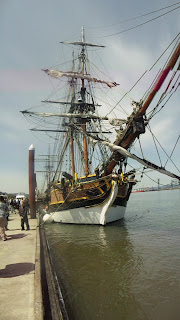The two big acts of stitch and glue boat construction are, naturally, stitching and gluing. Actually, there is another act, sanding, which is several times longer than the first two acts combined, but that'll be a subject for another post.
In the last post, I reported that I had finished the stitching phase (at least on the lower hull). Before making things permanent, I spent some making sure everything was level, aligned, and generally in the right position. I did some test fits of various parts (e.g. the foredeck), to make sure things were taking the proper shapes. Next up I grabbed a bunch of shims and started leveling the hull. A bubble level on top of a stiff batten spanning the hull athwartships to get things level laterally, and get out any twist that may have been present. The same bubble level on the bottom of the keel helped guide the longitudinal levelling. Various diagonal measurements helped get everything square. On and on. And of course, it was an iterative process, but slowly things began to converge, and soon I was happy. It took a while, but it is time well spent. Looking at a crooked bulkhead for the rest of the life of the boat would really make you regret skimping on a few hours here.
 |
| View of the bow. I dropped the foredeck in place for test fitting. Here it is being propped up by a clamp. |
 |
| The assembled hull. |
 |
| Test fit of the fore decks. |
 |
| Yup, the hull is level! |
 |
| I used this long, stiff batten to checking the alignment and heights of the floors and the cleats that'll support the cabin sole. |
The next step was to mix up a batch of Jon's magic thicken epoxy blend #4 and run little beads of thickened epoxy along all the seams between the stitches. The manual refers to them as "tack welds." I don't really like that term, but lacking something more proper, I have found myself unable to avoid thinking of them using that term. These hold the boat together so that you can pull out all the stitches. After that, you run big epoxy fillets over the the tack welds to provide some real structural strength.
For these steps, the epoxy has to be thickened just right. Too thin and it'll sag and run, too thick and it gets course, grainy, and hard to apply. For best results, I mix my epoxy, and then add thickener until it roughly doubles the volume of the epoxy. The exact amount is a matter of judgement whilst you are mixing, but as a rough rule of thumb, my doubling the volume rule sure seems to work well. For thickeners, I usually use a mix that is about 20% colloidal silica (cabosil) and 80% wood flour by volume. This seems to give the right balance in terms of smoothness, strength, and sandability.
 |
| Thickened epoxy "tack welds" |
With the tack welds done, the next step will be to move on to the big structural fillets.
I don't know what's wrong with me, but it seems that I have a tough time only working on one boat at a time. When I was 80% done with my Redfish cedar strip kayak, I started work on a Pygmy Osprey Double kayak. As I could see the light at the end of the tunnel on that one, I started work on this boat. And now, yes, I find myself working on yet another boat (sort of). This time it is a CLC cradle boat. This little boat/piece of furniture more-or-less a 1/2 sized version of CLC's Eastport Pram, with some modifications to turn it into baby cradle. I'm building this as a gift for some friends who are expecting. And hopefully not reading this. Thanks to John C. Harris and the guys at Chesapeake Light Craft for this unique and beautiful product.
 |
| Boat #5! (4.5?) Cradle boat under construction. |




























